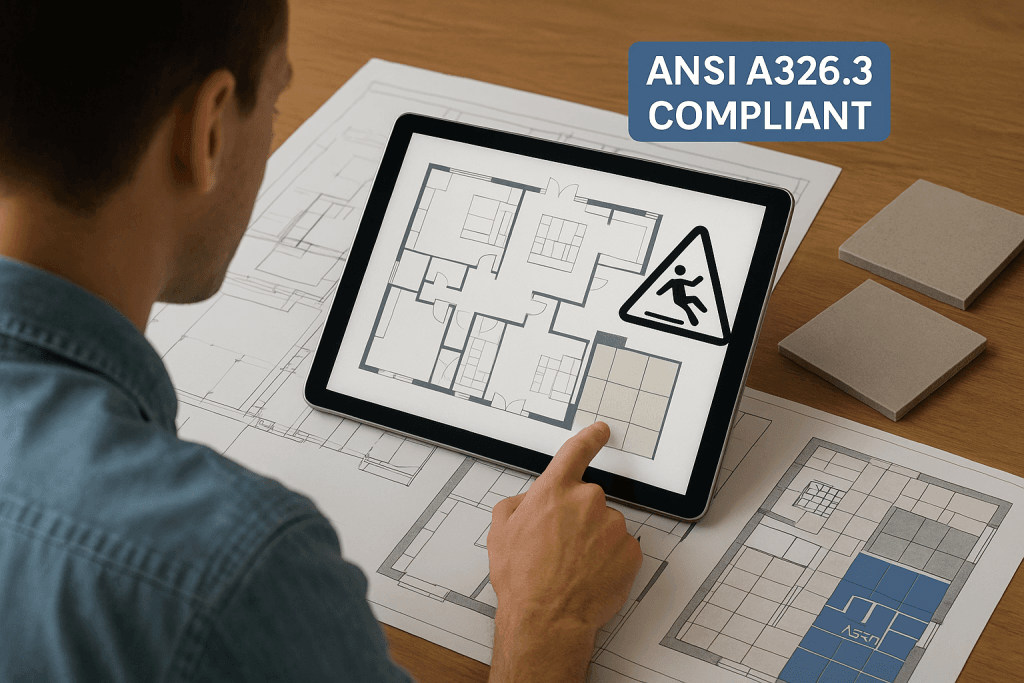
When it comes to creating safe, stylish, and code-compliant spaces, flooring choices matter more than most people realize. That’s why many architects and designers now rely on ANSI A326.3 and ANSI A137.1, the American National Standard for measuring the dynamic coefficient of friction (DCOF) of hard surface flooring materials before a single tile is laid. From preventing costly redesigns to ensuring long-term liability protection, early adoption of this standard is quickly becoming best practice.
Understanding ANSI A326.3 and ANSI A137.1: More Than a Safety Box to Check
ANSI A326.3 and ANSI A137.1 set the benchmark for evaluating the slip resistance of flooring surfaces under wet conditions. It’s a scientific method that helps predict how safe a floor will be, especially when moisture is involved.
While the minimum DCOF value required for interior spaces exposed to water is 0.42, that number doesn’t tell the full story unless it’s factored in from the start of the design process.
Designers who plan with these ANSI standards in mind can avoid picking materials that may look beautiful but fail safety testing later. By aligning style with safety from day one, projects stay on track and within budget.
Avoiding Expensive Revisions and Delays
One of the top reasons designers prioritize ANSI A326.3 early is to prevent rework. If a flooring choice doesn’t meet the standard after installation, the only solution may be removing and replacing the material, a nightmare for both budgets and timelines.
By evaluating slip resistance during the planning and specification phase, designers ensure that materials pass required testing before they even reach the job site. This foresight eliminates the stress of last-minute substitutions or compliance failures.
Enhancing Safety in High-Traffic Spaces
For commercial properties like shopping malls, hospitals, schools, and hotels, safety isn’t optional; it’s essential.
Designers who specify ANSI A326.3 tested materials help their clients create environments where slips and falls are far less likely, particularly in areas prone to spills or moisture, such as entryways, restrooms, and kitchens.
Incorporating these standards early gives designers peace of mind knowing they’ve contributed to a safer built environment while also helping clients reduce liability and insurance risks.
Improving Collaboration with Contractors and Inspectors
When architects and interior designers bring ANSI A326.3 data into design meetings, they signal a proactive approach. Contractors appreciate knowing that the selected materials already meet slip resistance requirements. Inspectors, too, are more likely to greenlight a project without delays when they see documentation supporting ANSI A326.3 compliance.
This kind of transparency builds trust across the entire construction team, improving workflow and minimizing friction during inspections.
Supporting Green Building and Accessibility Goals
Using ANSI A326.3 from the start also supports other design goals, such as LEED certifications or ADA (Americans with Disabilities Act) compliance. Slip resistance is critical to accessible design, especially for individuals with mobility aids.
Designers focused on sustainability and inclusivity find that early attention to slip resistance complements their broader objectives without compromising aesthetics.
ANSI A326.3 Isn’t Just for Compliance It’s for Better Design
In today’s fast-paced construction world, smart design goes beyond form and function. It anticipates safety, liability, and longevity. By adopting ANSI A326.3 during the earliest stages of project planning, designers are doing more than just following regulations they’re creating safer, more successful spaces for everyone who walks through them.


















